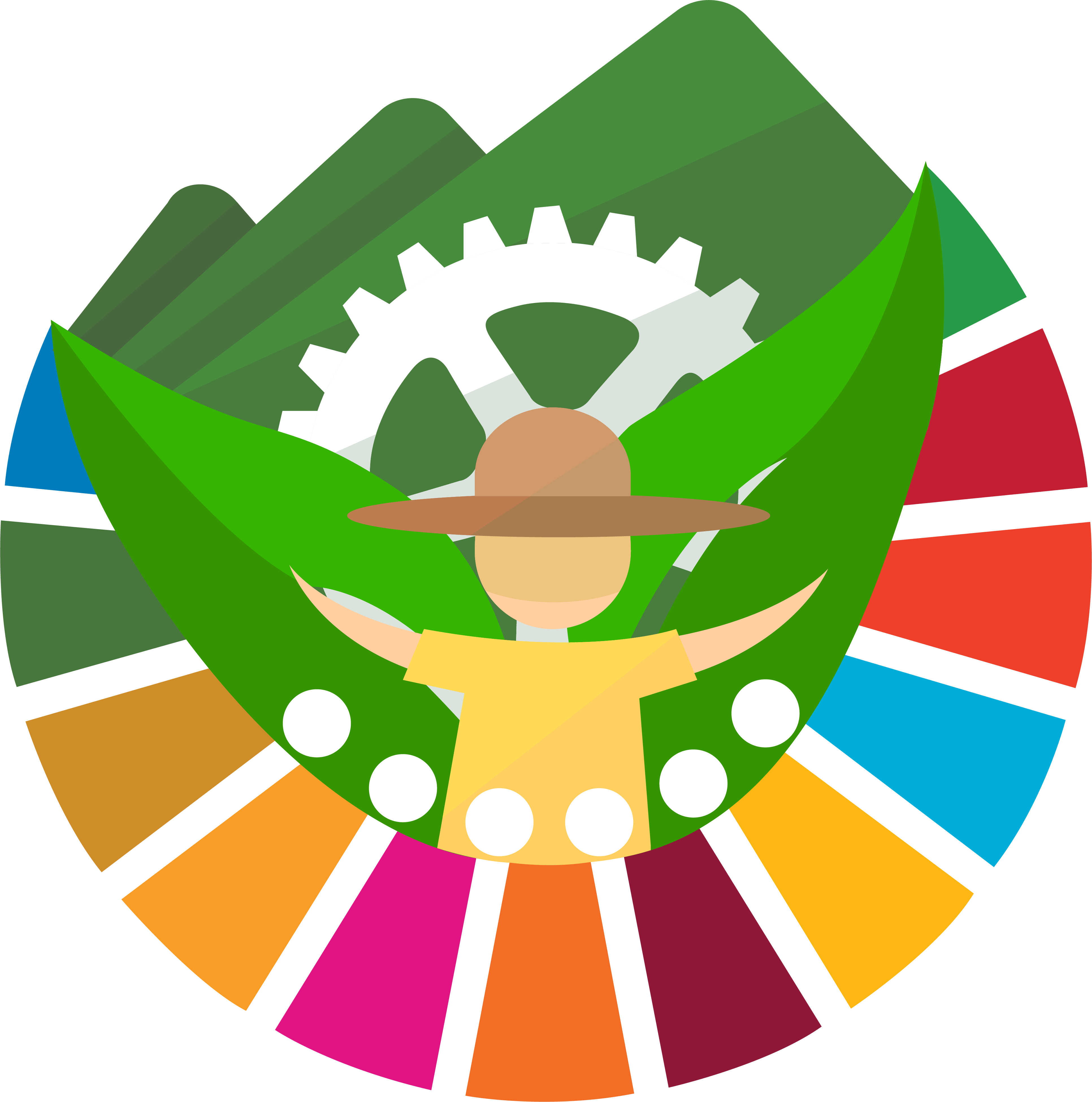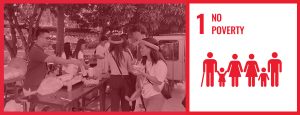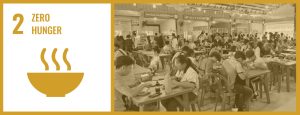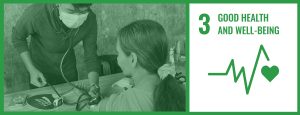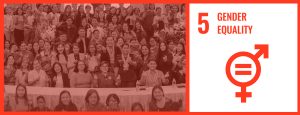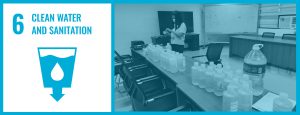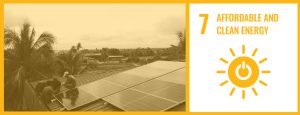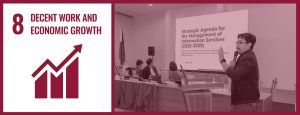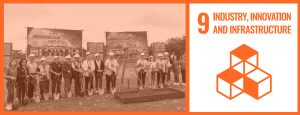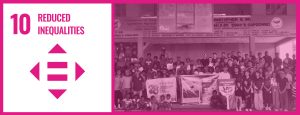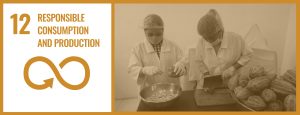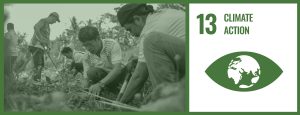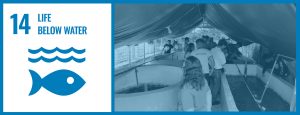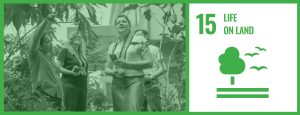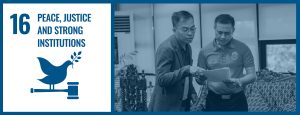2024 Research | SDG 13 – Climate Action
Research Programs
Mobile Solar Generator: A Disaster Resilient Power Source
Proponent: ROMEL B. CRISTOBAL
Abstract
The Mobile Solar Generator (MSG) was created to offer a backup source of electricity for homes, businesses, and schools, particularly during power outages caused by natural disasters. It makes use of both solar power technology and the concept of an ordinary AC generator. The MSG was developed using an old coaster (minibus) with four units of 330-watt monocrystalline photovoltaic (PV) panels mounted on its roof. Additionally, two units of 250 ampere-hour by 12 volts gel-type deep cycle batteries, a 3-kilowatt inverter, a 40-ampere solar charge controller, and accessories were installed inside the coaster to complete the system.
This project implemented the Analysis, Design, Development, Implementation, Testing, and Evaluation (ADDIE) model. Performance testing focused on component voltage, battery voltage, charging current, charging capacity, and abnormality codes. The findings showed that charging is feasible between 7:00 AM and 5:00 PM and optimal between 8:30 AM and 3:30 PM during sunny weather. The charging capacity was highest during SWOL conditions, reaching 210.5 ampere-hours. Discharging time was longer during sunny and cloudy weather, with discharging under load being longest in sunny conditions. The payback period for this system is estimated at twenty-five (25) months.
Solar-Powered Automobile Air-con System
Proponents: ROMEL B. CRISTOBAL, RICHARD P. ESCALANTE, OSCAR G. BANGAYAN, JOEMARIE V. JOVELLAR
Abstract
The Solar-Powered Automobile Air-con System (SPAAS) was created as a replacement for the original design of the automobile air-con system. The SPAAS was installed on an old coaster (minibus) with four units of 330-watt monocrystalline photovoltaic (PV) panels mounted on its roof. Additionally, a 3-kilowatt inverter, a 40-ampere solar charge controller, two units of 250 ampere-hours by 12-volt gel-type deep cycle batteries, and a 1-hp split-type air conditioner were also installed inside the coaster to complete the system.
This study addresses the growing need in the transportation sector for green and energy-efficient solutions. The technique lowers carbon emissions and eliminates the need for conventional fossil fuels by using solar radiation, which is abundant and free, to power a refrigeration cycle. To ensure effective energy conversion and storage, the proposed design combines photovoltaic panels, a battery storage system, and an optimized air-con system unit.
The system’s performance qualities, energy efficiency, and economic viability are examined as this study investigates its technological feasibility. Additionally, it discusses the potential environmental benefits and challenges associated with the widespread adoption of Solar-Powered Automobile Air-con Systems.
Development of Upgradable Solar-Hybrid Technologies for Disaster Response, Climate Change Adaptation and Mitigation
Proponents: Franklin A. Samonte, Warlito D. Antonio, Restituto C. Miguel
Abstract
This study evaluates the viability of a hybrid-powered irrigation system that integrates a monocrystalline photovoltaic (PV) module and the local electric utility to supply a submersible pump for agricultural applications. The performance characteristics of the PV module, considering its maximum power output and optimal operating voltage, demonstrate its capability to efficiently harness solar energy. The submersible pump, rated at 1 HP, effectively supports irrigation needs with a maximum flow rate of 0.32 m³/min and a maximum head of 15 meters.
However, financial analyses reveal significant challenges. The break-even analysis indicates a recovery period of approximately 11.9 years, suggesting considerable investment risk. Additionally, the negative Net Present Value (NPV) over 15 and 20 years highlights that projected costs exceed expected benefits, interpreting the project as financially unviable. The Benefit-Cost (B/C) ratio of less than 1 emphasizes that the costs outweigh the benefits, yielding only 0.53 to 0.59 PHP for every peso spent.
This study concludes that while the hybrid system offers technical advantages, the current financial framework necessitates reassessment and strategic adjustments to enhance economic sustainability and encourage adoption among farmers. Recommendations include exploring financial incentives, optimizing operational efficiencies, and investing in farmer education.
“Application of simple nutrient plus vermi tea on high-value crops for NFT hydroponics system under controlled climatic condition.”
Proponents: Franklin A. Samonte, Marion Caraui, Mark Joseph Reyes
Abstract
Application of simple nutrient plus vermi tea on high-value crops for NFT hydroponics system under controlled climatic conditions.
Based on the results of the research study, the developed hydroponics system was feasible to design and develop as a small-scale hydroponics system using locally and commercially available materials. The respondents concurred and accepted the design and construction, aesthetics, technical operation, and relevance of the study of the small-scale hydroponics system.
Application of simple nutrient plus vermi tea at 75% and 100% enhanced the growth and development of lettuce, as manifested in the yield per plant. The return on investment was obtained due to low electricity consumption, and the production of lettuce under the developed hydroponics system applied with Simple Nutrient plus Vermi Tea was highest in T2 – 100% of SNAP + Vermi Tea = 295.60%.
Empowering Communities: Design,Fabrication, and Evaluation of Mobile Solar-Powered Charging Stations with Integrated Street Lighting and Automated Water Refilling Station for Disaster Resilience
Proponents: Jolan Baccay Sy, Jake La Madrid, Allen M. Paz
Abstract
This study investigates the design, fabrication, and evaluation of mobile solar-powered charging stations integrated with street lighting and automated water refilling systems, aimed at enhancing disaster resilience in rural communities, particularly at the Cabagan Riverside Evacuation Center. The primary objectives were to address energy and water accessibility challenges during natural disasters, develop functional designs for diverse community needs, and utilize sustainable materials for durability.
The innovative approach combines solar-powered charging, street lighting, and automated water refilling into a single mobile unit. Engineered to provide essential energy, lighting, and water access for one week in disaster-affected areas, the station features a lightweight frame, high-efficiency solar panels (330 watts), and a 100Ah battery. Multiple USB ports facilitate device charging, while integrated LED lighting enhances nighttime safety. The automated water refilling system employs ultrasonic sensors and an Arduino microcontroller for efficient water dispensing.
Evaluation through a structured questionnaire revealed significant improvements in energy access and safety, with high satisfaction among community members. This study underscores the potential of solar-powered solutions to strengthen disaster resilience and promote sustainability in vulnerable regions, offering valuable insights for policymakers and practitioners in disaster management.
Development of an Automated Solar (Autosolar)Powered Biowaste Processing Machine
Proponents: Michelle Ann M. Calubaquib,Ph.D., Engr. Jolan B. Sy, Engr. Jake D. La Madrid, Engr. Samuel R. Simon, Ambrose Hans G. Aggabao, Ph.D.
Abstract
This research focused on the design, optimization, and integration of a biowaste processing machine, or biodigester, and a 16 kW solar photovoltaic (PV) system to create a sustainable and efficient solution for converting agroforestry waste into compost. The biodigester operates through aerobic decomposition, utilizing a control system that monitors and regulates temperature, humidity, and soil moisture to ensure efficient compost production. This system includes sensors, a microcontroller, and a Human-Machine Interface (HMI) for real-time monitoring and control. The mobile 16 kW solar PV system, comprising 18 high-efficiency monocrystalline panels, converts sunlight into electricity, which is then optimized and stored using a Deye inverter and a high-capacity lithium battery managed by a Battery Management System (BMS) and active balancer. The successful integration of the biodigester and solar PV system resulted in a mobile biowaste processing unit capable of converting agroforestry wastes into organic fertilizers. The system’s mobility, flexibility, and reliance on solar energy ensured efficient and sustainable operation. Key findings included the production of compost with significant nutrient content (1.68% nitrogen, 0.14% phosphorus, 2.16% potassium, pH 7.12) when using a compost activator, maturing in 20 days. Compost without the activator had higher nitrogen and phosphorus but lower potassium content, maturing in 25 days. This study highlights the benefits of integrating renewable energy with biowaste processing technologies,
promoting sustainable agricultural practices and reducing environmental impact.
Soil Quality Assessment in Masipi East, Cabagan, Isabela, Philippines: An Input for S&T Based Gmelina (Gmelina arborea Roxb.) Plantation Establishment
Proponents: Emerson V. Barcellano, Bondee L. Peñaflor, Rocel S. Galicia, Adona Joana S. Urmeneta
Abstract
Soil analysis provides information necessary to set nutrient application targets and allows monitoring and detection of changes in soil parameters over time. This study aimed to determine the quality of soil in the farmlands of upland communities in Cabagan, Isabela.
Soil samples derived from pre-identified sites were collected following standard procedures, and the analysis was conducted at the laboratory of the Department of Agriculture. Results show that the average pH of the 15 sites was 5.46, which is moderately acidic. In terms of the concentration of organic matter (%N), the lowest (0.96) was recorded at Plot #5, while the highest (2.30) was recorded at Plot #1. The average O.M % (N) was 1.76, which is also classified as moderate.
Regarding phosphorus concentration (ppm), the lowest (2.8) was recorded at Plot #1, while the highest (14.4) was recorded at Plot #6, with an average concentration of 9.59 ppm, classified as low for an effective and efficient crop production system. The lowest recorded level of potassium concentration was at Plot #2, while the highest was at Plot #8, with a mean concentration of 184 ppm, classified as moderate. On the other hand, these sites are classified as low in terms of zinc concentration, with 0.04 ppm at Plot #4 and 0.48 ppm (the highest) at Plot #8, with a mean concentration of 0.17 ppm.
The findings necessitate: documenting actual production of local farmers and estimating the profitability of their existing production operations; interventions to inform local farmers of the analysis results and identify appropriate technical approaches to be introduced; and ensuring compliance with the recommendations of DA-CVIAL regarding fertilizer applications and suitable crops to be planted.
Keywords: Soil, Soil Quality, Soil Quality Assessment, Database
Disaster Vulnerability, Preparedness and Resilience of Selected Flood-Prone Barangays in Isabela: Towards Actionable Risk Communication Intervention
Proponents: Rosalinda S. Guingab, Myrna C. Cureg, Regina Blair S. Santiago, Rico Martin V. Dumale
Abstract
Disasters, such as flooding, are becoming increasingly frequent and costly. This research study aimed to determine the disaster vulnerability, preparedness, and resilience of households in the most flood-prone barangays of three municipalities in Isabela. A descriptive quantitative research design guided the conduct of this study, with a pretested and reliability-tested survey questionnaire as the research instrument. Simple random sampling was used to select the 140 respondents residing in the three barangays.
Indicators of preparedness and resilience reveal that the respondents were ill-prepared for flooding, with most living in one-storey houses made of lightweight materials. Inadequate proactive actions, such as a lack of savings for emergency needs and absence of a regular source of income—evidence of poor preparedness—compromise their resiliency and increase their vulnerability to the effects of flooding.
The respondents face challenges in absorbing financial losses should they experience extensive damage due to flooding. There is a need to further enhance households’ disaster preparedness and resilience. As an actionable risk communication intervention, developed IEC materials will be turned over to the MDRRMO of the three municipalities to be used during disaster capability-building programs, aiming to strengthen community preparedness and resilience.
Perceived Risks and Effects of Heat Stress to Students and their Coping Strategies
Proponents: Bondee L. Peñaflor, PhD, Beverly Gay N. Cambri, PhD
Abstract
The study assessed the perceived risks and effects of heat stress on students and their coping strategies, which could serve as input for policy and institutional innovations in schools. A cross-sectional survey research design was employed, covering 583 respondents. Data were analyzed using both descriptive and inferential statistics.
Results show that the perceived risks with the highest weighted mean are: “I am afraid that hot weather during these days can cause me an injury or sickness,” “People exposed to heat have a greater risk of developing serious diseases,” and “Heat is a potentially lethal risk.”
Meanwhile, the perceived effects of heat stress with the highest weighted mean include tiredness/exhaustion, difficulty in getting sleep resulting in decreased hours of rest, and inability to study well at home and in school due to excessive heat. To address these effects, students primarily coped by drinking cold water, juice, or carbonated drinks and keeping a personal tumbler for water. Additionally, they wore comfortable clothes to enhance thermal comfort, bathed more frequently, and utilized trees and parks as preferred resting spaces during hot days.
Finally, students expressed satisfaction (weighted mean ranging from 4.11 to 4.26) with the school’s efforts in addressing the effects of heat stress.
The study on perceived risks, effects, and coping strategies related to heat stress aligns with the United Nations Sustainable Development Goals (SDGs), particularly in the areas of good health and well-being (SDG 3), quality education (SDG 4), and climate action (SDG 13).
Flood Detection Using Multilayer Perceptron Algorithm
Proponent: Maribel S. Abalos
Abstract
The study addresses the pressing issue of flooding in the Philippines, focusing on the City of Ilagan, Isabela, a region frequently affected by seasonal floods. Floods pose significant threats to life, property, agriculture, and public health.
The research emphasizes the integration of modern technological advancements, such as robotics and the Internet of Things (IoT), in developing a flood detection system to enhance early warning capabilities. A flood detection system employing a multilayer perceptron (MLP) algorithm was developed to monitor flood levels and predict potential flooding. The system uses sensors such as rain gauges, LiDAR, and flow rate meters to measure precipitation, water levels, and flow rates, with data processed through a Raspberry Pi.
The study outlines the system’s architecture, evaluation, and threshold-based warning mechanism for public safety. The model, tested for accuracy, demonstrated high predictive performance with a 99% accuracy rate. While the system effectively detects flood levels, the study recommends further evaluation of alternative sensors and predictive algorithms, as well as expanding the system’s application to larger-scale flood-prone areas.
The findings aim to contribute to mitigating the impact of floods and enhancing disaster preparedness.
BotCoin: Bottle-Coin Vendind Machine
Proponents: Kelvin Kris C. Gonzales, Alvin B. Tañeza
Abstract
BotCoin: Bottle-to-Coin Vending Machine is a technological solution designed to alleviate the growing issue of plastic and can waste in San Mateo, Isabela, Philippines. This clever vending machine converts throwaway bottles/cans into cash, encouraging residents to recycle and promoting environmentally friendly activities. BotCoin aims to make recycling more accessible and engaging by combining technology and financial incentives, particularly among younger generations who are more likely to respond to tech-based solutions.
However, numerous challenges and issues have emerged in waste segregation practices in many communities. In recent years, local government has noticed an alarming rise of plastic bottles/cans garbage in public places, rivers, and landfills. Despite various environmental awareness programs, plastic recycling rates are still low, and inappropriate disposal contributes to environmental damage. Furthermore, the lack of a formal waste management system and readily available recycling programs makes it difficult for residents to actively participate in plastic trash reduction.
The increasing prevalence of plastic bottles and cans in the Philippines, despite existing waste management policies, highlights a significant challenge in environmental sustainability. The country is grappling with a substantial volume of plastic waste, with Quezon City alone generating approximately 262 tons of plastic waste daily, indicative of broader national trends (Sidhu et al., 2021). The Philippines ranks as the third-largest contributor to global mismanaged plastic waste, following China and Indonesia, which underscores the urgency of addressing this issue through effective waste management strategies (Deocaris et al., 2019).
Despite the enactment of the Ecological Solid Waste Management Act of 2000 (Republic Act 9003), which aims to enhance waste management practices, the effectiveness of these policies remains questionable. A study indicates that the lack of public awareness and inconsistent policy implementation are critical barriers to successful waste management (Chen et al., 2021).
With this, the BotCoin vending machine provides a localized, small-scale solution that is both inexpensive and feasible for rural areas such as San Mateo, Isabela. This innovation also addressed the gaps in other researches on incentivized recycling systems in developing countries, where economic and infrastructure constraints frequently impede effective waste management techniques.
This also represents a transformative approach to recycling and waste management, aligning individual and collective interests. It empowers individuals to contribute to a sustainable future while earning rewards for their actions. As more of these innovative machines will soon populate our towns and cities, we can look forward to a world where recycling pays dividends for both our wallets and our planet, making the Earth greener and wealthier, one recyclable at a time.
Enhancing the Basic Services on the Implementation of Sustainable Development Goals: The Municipality of San Mateo Case
Proponents: Rosalie C. Leal, Venus A. Diego
Abstract
The paper examines the role of Local Government Units (LGUs) in providing quality basic services in accordance with the United Nations’ Sustainable Development Goals (SDGs), specifically in the municipality of San Mateo, Isabela. The study seeks to confirm their accomplishments by evaluating the execution of fundamental services in accordance with the Sustainable Development Goals (SDGs). It concentrates on certain Sustainable Development Goals associated with agriculture, infrastructure, health, environmental management, tourism, education, and social services, highlighting the interaction between political and governance frameworks.
The study evaluates fundamental services, the integration of Sustainable Development Goals (SDGs), levels of satisfaction, and disparities among respondent groups, while proposing improvement initiatives. Results indicate significant integration and favorable evaluations, demonstrating a dedication to global sustainability. San Mateo’s distinguished status and multiple accolades highlight its dedication to the Sustainable Development Goals (SDGs). This research concludes that San Mateo delivers services equally, emphasizing inclusivity and equality. The affirmative association between integration and satisfaction underscores the significance of aligning services with sustainable development concepts. Recommendations encompass ongoing enhancement, needs assessments, periodic evaluations, community satisfaction surveys, adaptive action plans, and a specialized monitoring division. The study adds to what is known about sustainable development in local government by showing how integration, satisfaction, and the success of implementing the SDGs in LGU San Mateo are all connected.
Waste-Wise Cities for Sustainability: Establishment of a Material Recovery Facility for Waste Reduction Management and Promotion of Circular Economy
Proponents: Dr. Precila C. Delima, Dr. Lorelei C. Tabago, Dr. Marisol S. Foronda, Dr. Teresita C. Molano, Dr. Jonathan Lord R. Aquino
Abstract
The project, Waste Wise Cities for Sustainability: Establishment of a Material Recovery Facility (MRF) in Cauayan City, addresses the pressing need for sustainable waste management solutions in response to rapid urbanization and increased waste generation.
The MRF aims to reduce landfill dependency, mitigate pollution, and contribute to a circular economy by promoting waste recovery and resource reuse. Through a mixed-method approach, this study evaluates the MRF’s quantitative viability, including waste composition analysis and financial feasibility via metrics such as Return on Investment (ROI), Net Present Value (NPV), and Payback Period (PP).
Qualitative interviews reveal strong community support, highlighting anticipated benefits in job creation, environmental health, and waste awareness. Key findings indicate that the MRF can achieve financial sustainability by incorporating additional revenue sources, such as compost sales and partnerships with local businesses.
The project aligns with Sustainable Development Goals (SDGs), positioning the MRF as a replicable model for regional waste management and a catalyst for sustainable urban development.
Knowledge, Attitudes and Practices Towards Water Sanitation and Hygiene among Household Residents in Flash Flood Prone Areas in the City of Cauayan, Province of Isabela, Northern Philippines
Proponents: Paul Angelo A. Tamayo, Marisol S. Foronda, & Lorelei C. Tabago
Abstract
This study explored the knowledge, attitudes, and practices (KAP) towards Water, Sanitation, and Hygiene (WASH) among households in flash flood-prone areas of Cauayan City, Isabela, Philippines. Given the area’s susceptibility to flash floods, investigating household KAP in WASH is crucial for preventing disease outbreaks.
A cross-sectional, non-experimental research design was employed, and 100 household members were selected through purposive sampling from selected barangays. A questionnaire adapted from UNICEF was used to obtain information on handwashing, solid waste management, sanitation, and treatment of drinking water.
Findings revealed that most households understand key handwashing practices, with 91.59% washing hands before eating. However, knowledge gaps exist regarding hand hygiene before breastfeeding and water treatment. While most respondents use latrines, open defecation persists among children under five. Additionally, waste management practices and reliance on external water sources present concerns, especially during floods.
The study emphasizes the need for enhanced flood preparedness plans focusing on improving WASH practices and infrastructure, particularly in vulnerable communities. Recommendations include increasing outreach and education efforts and improving sanitation systems to mitigate health risks in flood-prone areas.
Navigating the Psychology of Climate Crisis: Contemporary Significance of Environmental Awareness and Eco-Anxiety among Gen Zs
Proponent: Marris R. Reyes
Abstract
This grounded study examined the emerging field of Climate Psychology, focusing on environmental awareness and eco-anxiety experiences that affect the mental wellness of Gen Z. It also explored Gen Zs’ perspectives on the psychology of the climate crisis. Thirty-seven (n=37) college students were purposively selected and subjected to in-depth interviews that documented their experiences with the extreme effects of climate change.
To answer the central question, “How do environmental awareness and experiences contribute to psychological vulnerability to eco-anxiety and resilience among Gen Zs?” the researcher employed the Glaserian coding method. Field texts were constantly compared, analyzed, and coded alongside theoretical modeling and sorting until themes emerged.
From this analysis, the Quadrant A of Eco-Anxiety and Climate Action was developed, yielding four distinct phases explaining awareness, eco-anxiety, and its effects on mental wellness among Gen Zs. The first quadrant, Awareness, emphasizes the role of social media and misinformation. The second, Anxiety, pertains to the echo of climate anxiety and the doomsday syndrome. The third, Academe, highlights the role of universities as catalysts for climate action. The fourth, Action, emphasizes moving forward toward climate action and sustainability. These quadrants do not form a perfect cycle, as they are influenced by positive and negative polarities representing the impact of eco-anxiety on Gen Zs’ engagement in climate change mitigation and action.
IoT-Driven Smart Agriculture: Enhancing Climate Resilience and Sustainable Crop Management of corn production
Proponent: Reonel F. Ferreria
Abstract
Increasing the impact of climate change on traditional farming systems has led to the integration of agriculture with the Internet of Things (IoT). The study presents the possibility of providing climate resilience in agriculture through smart agriculture, which arises from the IoT. Focus is given to the use of IoT technologies like soil moisture sensors, weather monitoring, and automated irrigation that make corn farming’s operations efficient and turn out to be climate-adaptive. Despite its promise, IoT adoption is also facing some challenges like high cost and very rare technical expertise of farmers. Hence, the present study shall outline the merits, scope, and limits of IoT use in corn production along with specific objectives for crop yield enhancement and resource sustainability.
